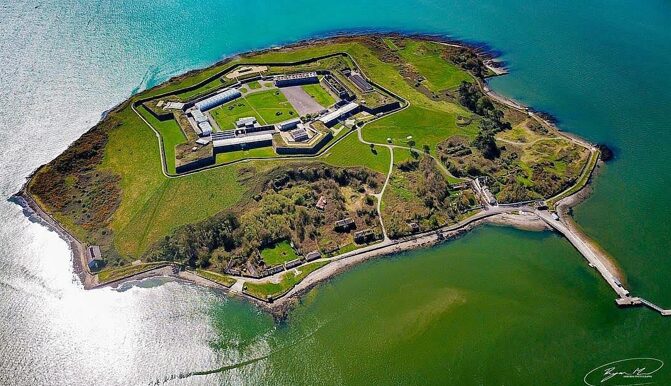Picture this: you’re wandering through Ireland, a land not just known for its breathtaking green landscapes, lively pubs, and warm-hearted people, but also for its deep, often heartbreaking history. It’s a place where every hill, valley, and stone has a story to tell. But today, we’re not talking about fairytale castles or postcard-perfect cliffs; instead, we’re diving into something much darker — dark tourism. This unique, albeit niche, area of travel is growing in popularity as people seek out places linked to tragedy, death, and human suffering.
So, why do people visit these places? Well, dark tourism offers an opportunity to learn from the past, pay homage to those who suffered, and reflect on the weight of history. With over five years of exploring dark tourism hotspots worldwide, we’re excited to focus on Ireland, a country where the echoes of a turbulent past blend with the present in the most chilling, yet fascinating, ways.
Spike Island: Ireland’s Alcatraz
Nestled in County Cork, Spike Island stands as one of Ireland’s most haunting historical landmarks. Imagine walking through stone-cold prison cells, with the feeling that the walls could talk — whispering stories of Ireland’s rebellions, hardships, and the people who paid the ultimate price for their beliefs. Often dubbed “Ireland’s Alcatraz,” this eerie island has been home to a monastery, a fortress, and most notably, a prison that housed thousands of inmates.
As you wander through the long, empty corridors of Spike Island’s prison, there’s a heavy weight in the air. The bleakness of the prison cells, combined with the stories of isolation and punishment, creates an atmosphere that’s hard to shake off. It’s a place where Ireland’s struggles for freedom and justice are carved into every stone, and at night, as shadows creep in, it feels as though the past comes alive to walk with you.
Jeanie Johnston Tall Ship: A Famine Tale
In the heart of Dublin’s docks lies the Jeanie Johnston Tall Ship, a deeply moving reminder of Ireland’s Great Famine — a period that devastated the country in the mid-19th century. The famine, caused by potato blight and worsened by political mismanagement, forced millions of Irish people to leave their homeland in search of a better life. The Jeanie Johnston was one such vessel, carrying hope and sorrow across the Atlantic.
Stepping aboard the ship transports you back in time. The ship’s wooden planks seem to creak with the weight of history, and as you walk through its cramped quarters, you can almost hear the whispers of those who embarked on this perilous journey. Their dreams of starting anew mingled with the heartache of leaving their homeland behind. Visiting the Jeanie Johnston is a somber experience, reminding us of the resilience of those who survived one of Ireland’s darkest times.
Kilmainham Gaol: Freedom’s Price
Next, we head to Kilmainham Gaol, one of Dublin’s most infamous dark tourism sites. This former prison tells the story of Ireland’s long fight for independence, housing many of the country’s revolutionary leaders, including those who fought in the Easter Rising of 1916. The prison’s cold, damp walls have seen both heroes and ordinary people imprisoned, many of whom never walked out.
Kilmainham’s atmosphere is oppressive, almost suffocating. The narrow, stone-lined cells once housed political prisoners who faced execution for their defiance. Walking through the gaol, there’s an eerie sense of despair and sacrifice. The echoes of the past seem to cling to the walls, reminding visitors that freedom has always come at a high price. It’s impossible not to feel moved by the stories of those who fought and died for Ireland’s independence.
Titanic Belfast: A Tragic Tale of Hubris
From Dublin, we travel north to Titanic Belfast, where the legendary Titanic was built. You might think that a museum dedicated to one of the world’s most famous ships couldn’t possibly be dark or scary, but you’d be wrong. The Titanic, a symbol of human ingenuity and hubris, met a tragic fate, taking more than 1,500 souls with it into the icy Atlantic.
Titanic Belfast masterfully captures the excitement and pride surrounding the ship’s construction, but as you move through the exhibitions, a sense of dread begins to settle in. Personal stories of those who perished, haunting images of the wreck, and eerie artifacts from the ship’s remains make this experience deeply emotional. It’s a chilling reminder of how quickly dreams can turn into nightmares, and how the ocean’s power can humble even the greatest human achievements.
Crumlin Road Gaol: Belfast’s Shadowed History
Still in Northern Ireland, Crumlin Road Gaol offers a glimpse into one of the darkest periods of Irish history — The Troubles. This former prison, located in Belfast, was notorious for holding political prisoners during the conflict between Protestant unionists and Catholic nationalists. The Troubles, a period marked by violence, bombings, and political strife, left deep scars on Northern Ireland, and Crumlin Road Gaol stands as a stark reminder of those tumultuous years.
Walking through the prison’s cold, echoing corridors, it’s easy to imagine the tension and fear that once permeated its walls. Stories of escape attempts, executions, and the harsh realities of prison life during The Troubles make this an emotionally charged experience. For some, the gaol’s dark history is heightened by reports of paranormal activity — visitors have claimed to feel the presence of those who once walked its halls, adding an extra layer of intrigue to this already chilling site.
Doagh Famine Village: Life Amidst Despair
In County Donegal, the Doagh Famine Village offers an immersive experience into one of Ireland’s darkest periods — the Great Famine. Unlike the Jeanie Johnston, which focuses on the journey away from Ireland, the Doagh Famine Village lets you walk in the shoes of those who stayed behind, battling starvation, disease, and despair.
As you wander through the thatched cottages, you can feel the hardship faced by families struggling to survive. Each exhibit tells a different story, from the day-to-day grind of life during the famine to the heartbreaking decisions many had to make. This somber village, set against Donegal’s rugged landscape, offers a profound insight into a period that shaped the nation’s history. It’s not just a lesson in survival, but a testament to the resilience of the human spirit.
Doolough Valley Memorial: A Walk of Tragedy
In County Mayo, the Doolough Valley Memorial stands as a tribute to those who perished during the Great Famine. This hauntingly beautiful valley was the site of a tragic event — famine victims, forced to walk miles in search of food, were met with harsh conditions, and many did not survive. The memorial is a stark reminder of the desperation and hopelessness faced by the Irish during the famine.
The rugged, desolate landscape surrounding the memorial adds to its chilling atmosphere. The wind seems to carry the echoes of those who walked this path, making it impossible not to feel the weight of their suffering. It’s a place of quiet reflection, where visitors can pay their respects to those who lost their lives in one of Ireland’s darkest chapters.
Leap Castle: Ireland’s Most Haunted
And finally, we arrive at Leap Castle in County Offaly — perhaps the most bone-chilling destination on our dark tourism journey. Known as one of the most haunted castles in Ireland, Leap Castle is shrouded in ghostly legends and tragic tales. Its history is marked by betrayal, murder, and unexplained phenomena, making it a must-visit for anyone intrigued by the paranormal.
The castle’s infamous Bloody Chapel, where prisoners were thrown into a dungeon and left to die, adds to its terrifying allure. Visitors often report strange occurrences — cold spots, ghostly apparitions, and the feeling of being watched. If you’re brave enough to visit at night, the castle’s eerie atmosphere is guaranteed to send shivers down your spine.
Conclusion: Embracing the Shadows of Ireland’s Past
Dark tourism in Ireland is more than just an exploration of spooky sites; it’s a journey into the heart of the country’s history, culture, and identity. Each destination we’ve covered tells a story of human suffering, resilience, and the impact of historical events that continue to shape Ireland today. These places offer not just education, but also an emotional connection to the past, making them vital for preserving the memory of those who came before us.
Whether it’s the political prisoners of Kilmainham Gaol, the famine victims aboard the Jeanie Johnston, or the haunted halls of Leap Castle, Ireland’s dark tourism sites provide a unique, unforgettable travel experience. So, the next time you find yourself in the Emerald Isle, why not take a step off the beaten path and explore its darker side? You never know what stories you might uncover.
Remember, no matter where your travels take you — Travel Till You Drop!






Comments